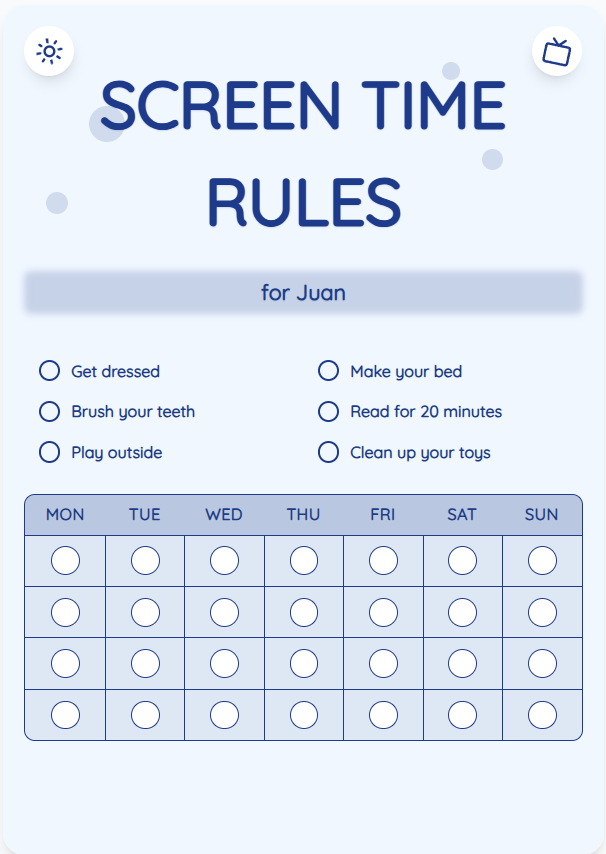Screen Time Management: Navigating 12 Hours of Screen Time for Children
As parents, balancing screen time for kids can be challenging, especially when faced with the prospect of managing 12 hours of screen time. In this guide, we provide actionable advice and practical tips to help you navigate this extensive screen time while promoting your child's development and maintaining family harmony.
See What Your Screen Time Chart Will Look Like
Here's an example of a beautiful, customizable screen time rules chart you can create for your family

Understanding the Impact of Excessive Screen Time
Excessive screen time can have detrimental effects on children's physical health, mental well-being, and social skills. Research indicates that prolonged screen use can lead to sleep disturbances, obesity, behavioral issues, and poor academic performance. By understanding these risks, parents can take proactive steps to manage their child's screen time effectively.
Setting Healthy Screen Time Limits
Establishing clear and consistent screen time limits is essential when dealing with 12 hours of screen time. Create a screen time schedule that includes designated breaks for physical activity, family interactions, and other non-screen activities. Utilize screen time charts from ScreenTimeRules.com to visually represent and reinforce these limits to your child.
Put These Tips Into Action
Create a custom chart to implement these strategies with your child
Promoting Alternatives to Screen Time
Encourage your child to engage in a variety of non-screen activities such as reading, outdoor play, arts and crafts, and family outings. Providing stimulating alternatives can help reduce reliance on screens and foster creativity, imagination, and social skills. Use screen time charts as a tool to incentivize and track non-screen activities effectively.
Creating a Screen-Free Environment
Designate screen-free zones in your home, such as the dining area and bedrooms, to promote healthy boundaries around screen use. Implement tech-free hours during meals and before bedtime to encourage quality family time and better sleep hygiene. By creating a conducive environment, you can gradually decrease your child's screen time without conflicts.
Practical Tips for Success
- Involve your child in setting screen time limits to promote ownership and responsibility.
- Use positive reinforcement and rewards for adhering to screen time rules.
- Model healthy screen habits by limiting your own screen time in front of your child.
- Encourage open communication with your child about the benefits of balanced screen use.
Frequently Asked Questions
Is it harmful for children to have 12 hours of screen time per day?
Excessive screen time can have negative consequences on children's health and development. It is important to set limits and encourage a balanced approach to screen use.
How can I motivate my child to reduce their screen time?
Offer incentives such as extra playtime, special outings, or small rewards for decreasing screen time. Use visual aids like screen time charts to make progress visible and rewarding.
What are the signs that my child is spending too much time on screens?
Signs of excessive screen time include irritability when screens are taken away, neglecting other activities, disrupted sleep patterns, and declining academic performance.
By implementing these strategies and tips, you can effectively manage 12 hours of screen time for your child while fostering their overall well-being. Visit ScreenTimeRules.com to create personalized screen time charts that support your efforts in promoting healthy screen habits and family balance.
Ready to Transform Your Family's Screen Time?
Join thousands of parents who have successfully managed screen time with our customizable charts.
